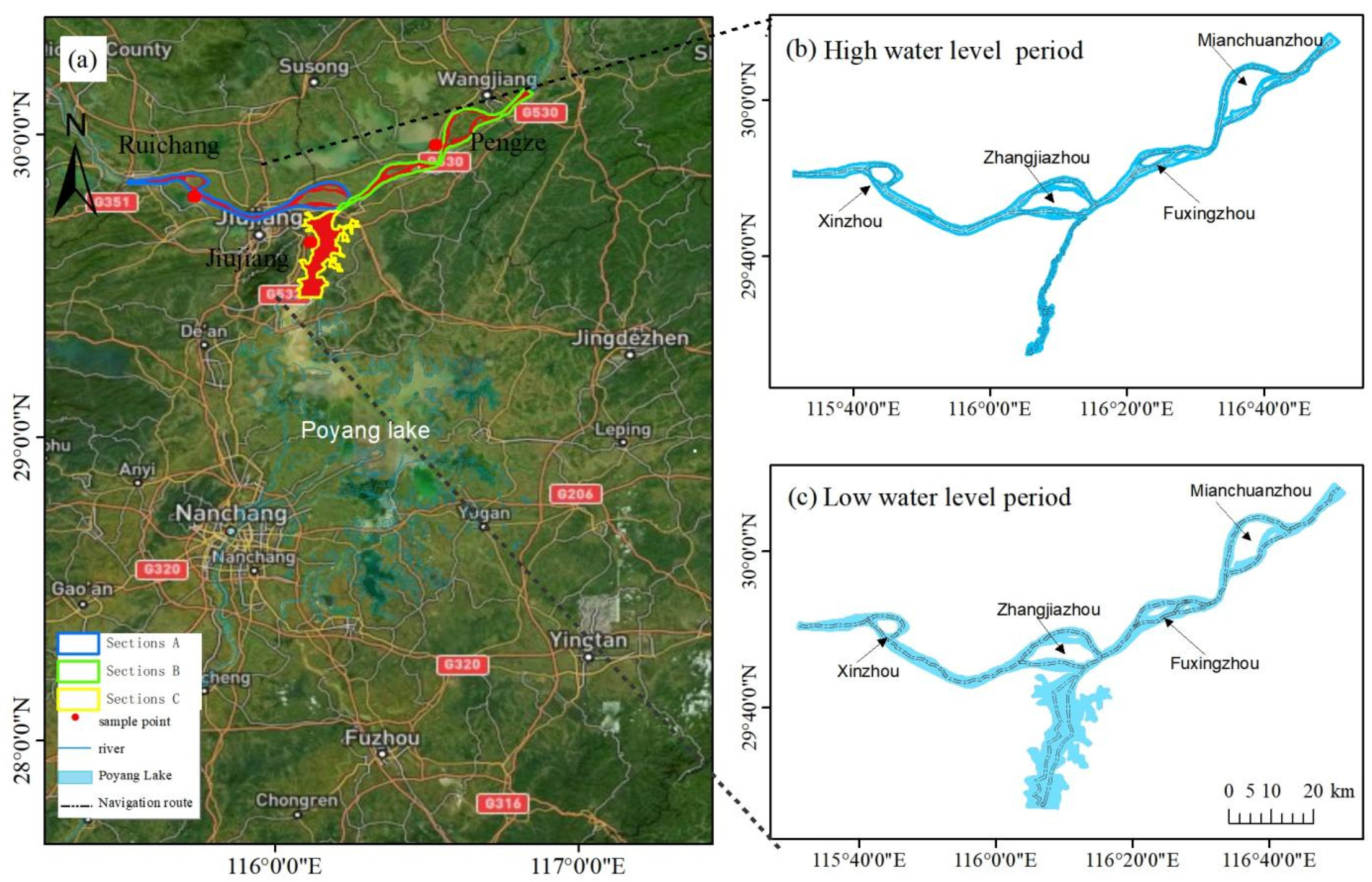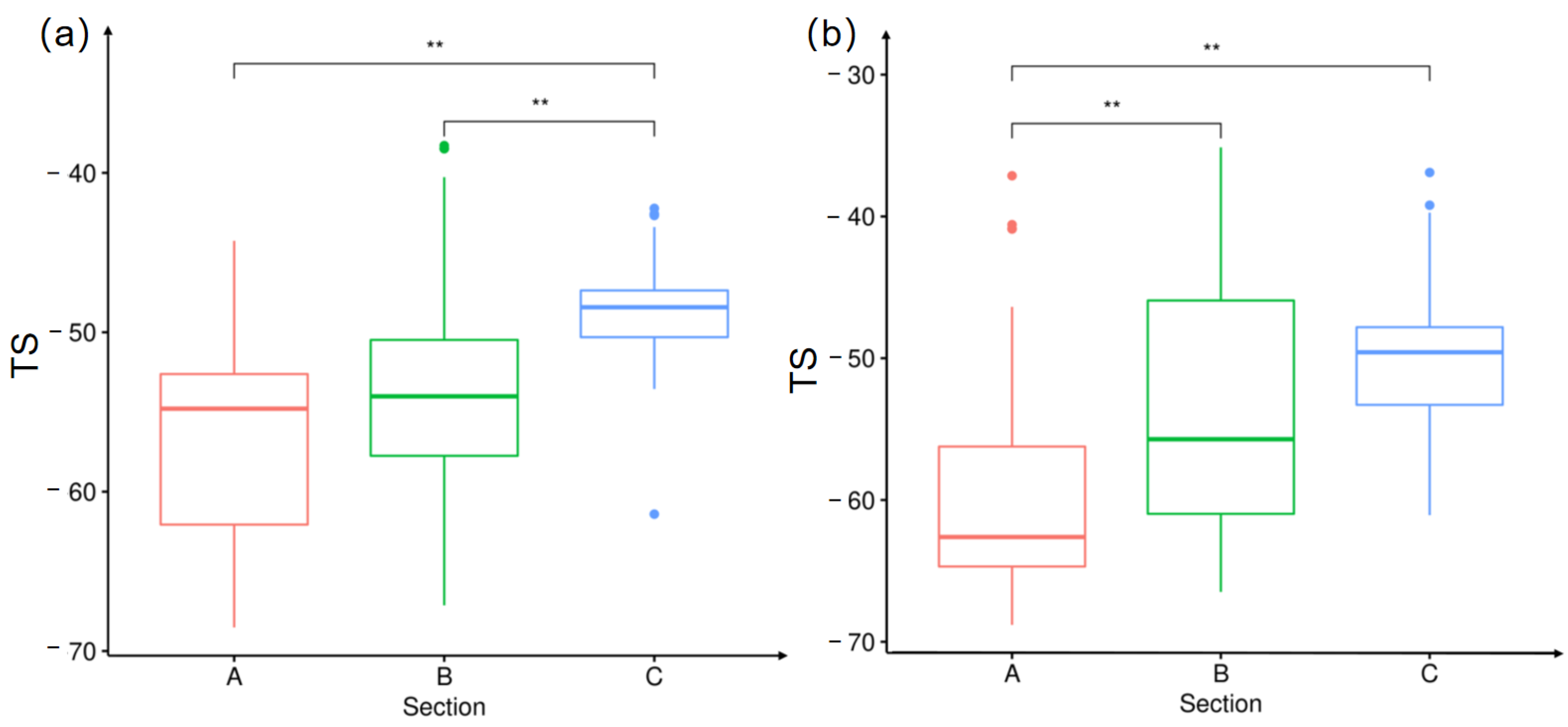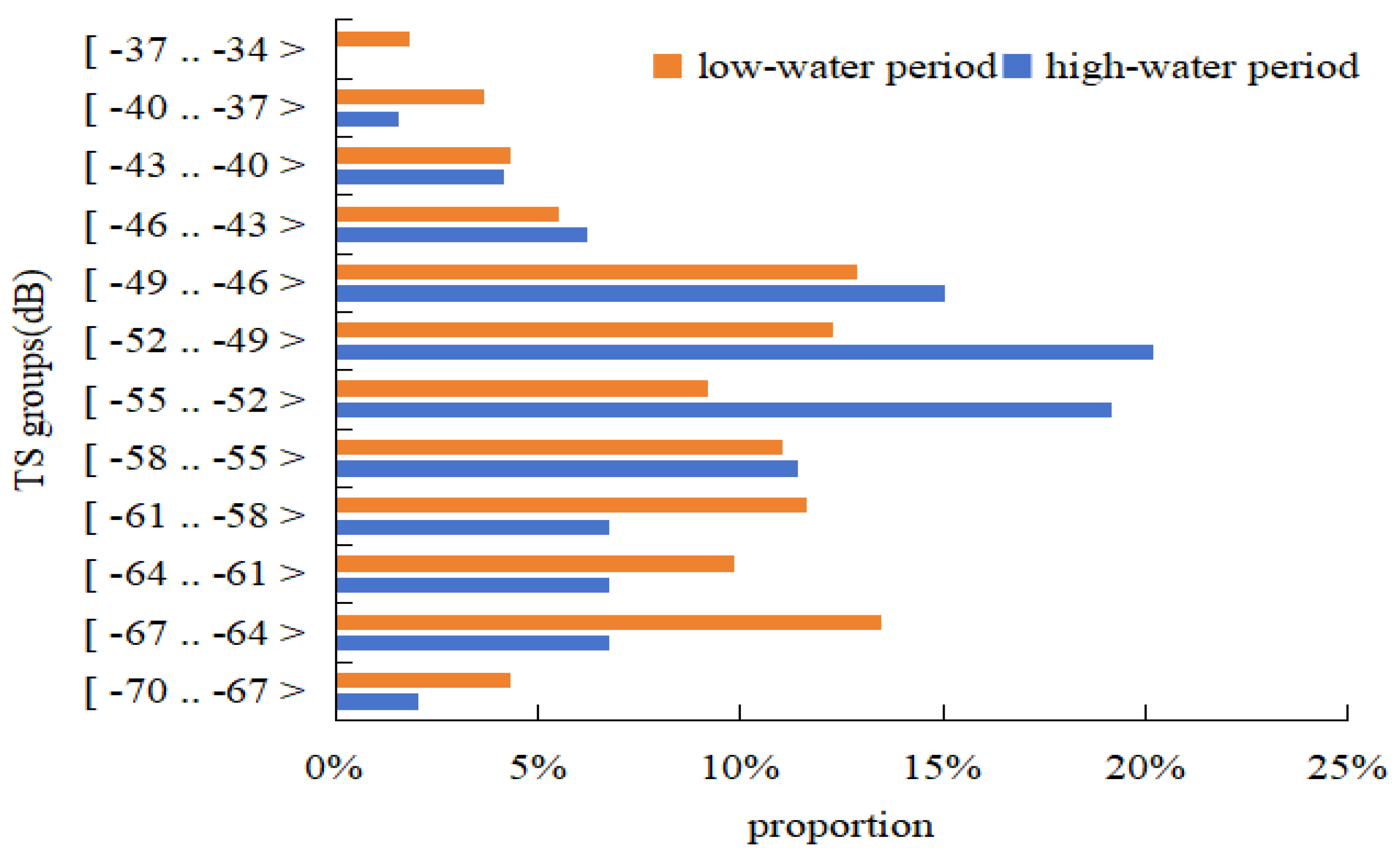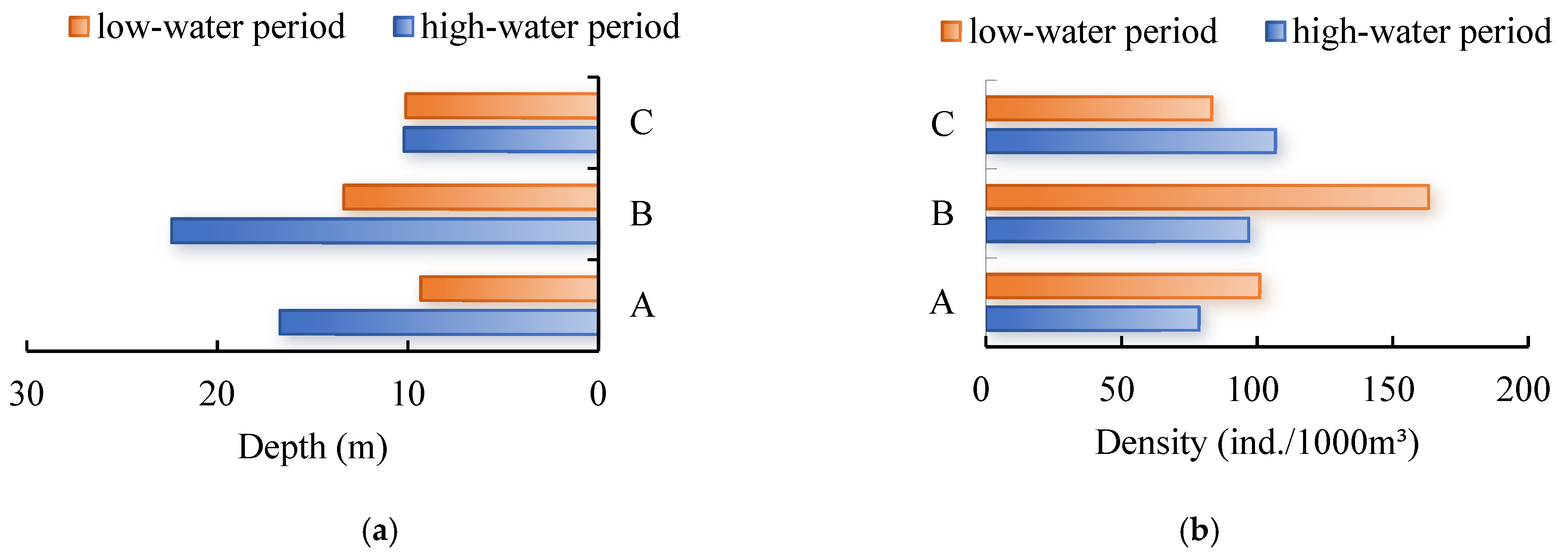Temporal and Spatial Distribution Characteristics of Fish Resources in a Typical River–Lake Confluence Ecosystem During the Initial Period of Fishing Ban
Abstract
1. Introduction
2. Materials and Methods
2.1. Study Area and Procedures
2.2. Data Processing and Transformation
3. Results
3.1. Fish Target Strength and Spatial Distribution Characteristics
3.2. Spatial Distribution Characteristics of Fish Density
3.3. Composition of Fish Population
4. Discussion
4.1. Spatial and Temporal Characteristics of Fish Density
4.2. Fish Target Strength
4.3. Changes in Fish Resources Before and After the Fishing Ban
5. Conclusions
Supplementary Materials
Author Contributions
Funding
Institutional Review Board Statement
Informed Consent Statement
Data Availability Statement
Conflicts of Interest
References
- Dronova, I.; Beissinger, S.R.; Burnham, J.W.; Gong, P. Landscape-Level Associations of Wintering Waterbird Diversity and Abundance from Remotely Sensed Wetland Characteristics of Poyang Lake. Remote Sens. 2016, 8, 462. [Google Scholar] [CrossRef]
- Xu, G.; Qin, Z. Flood Estimation Methods for Poyang Lake Area. J. Lake Sci. 1998, 10, 31–36. [Google Scholar] [CrossRef]
- Feng, L.; Hu, C.; Chen, X.; Li, R.; Tian, L.; Murch, B. MODIS observations of the bottom topography and its inter-annual variability of Poyang Lake. Remote Sens. Environ. 2011, 115, 2729–2741. [Google Scholar] [CrossRef]
- Li, Y.; Qian, F.; Silbernagel, J.; Larson, H. Community structure, abundance variation and population trends of waterbirds in relation to water level fluctuation in Poyang Lake. J. Great Lakes Res. 2019, 45, 976–985. [Google Scholar] [CrossRef]
- Huang, L.; Wu, Z.; Li, J. Fish fauna, biogeography and conservation of freshwater fish in Poyang Lake Basin, China. Environ. Biol. Fishes 2013, 96, 1229–1243. [Google Scholar] [CrossRef]
- Li, Y.; Zhang, Q.; Cai, Y.; Tan, Z.; Wu, H.; Liu, X.; Yao, J. Hydrodynamic investigation of surface hydrological connectivity and its effects on the water quality of seasonal lakes: Insights from a complex floodplain setting (Poyang Lake, China). Sci. Total Environ. 2019, 660, 245–259. [Google Scholar] [CrossRef] [PubMed]
- Hu, M. Analysis of Water Level and Water Environmental Characteristics of Poyang Lake and Its Impact on Fish Community and Migration; Nanchang University: Nanchang, China, 2009; pp. 56–89. [Google Scholar]
- Wang, S.; Duan, X.; Chen, W. Status and changes of fish resources in the Hukou area of Poyang Lake. Freshw. Fish. 2016, 46, 50–55. [Google Scholar]
- Tao, J.; Yang, J.; Xuan, Z. Preliminary Report on the Effects of Resource Recovery on Anadromous Coilia nasus in Poyang Lake Under the National 10-Year Fishing Ban. Process. Fish. Sci. 2022, 43, 7. [Google Scholar] [CrossRef]
- Dong, F.; Zhang, H.; Wei, Q. Protection and development after the ten-year fishing ban in the Yangtze River. J. Fish. 2023, 47, 029318. [Google Scholar] [CrossRef]
- Lian, Y.; Huan, G.; Godlewska, M.; Li, C.; Zhao, X.; Ye, S.; Li, Z. Hydroacoustic assessment of spatio-temporal distribution and abundance of fish resources in the Xiangxi river. Acta Hydrobiol. Sin. 2015, 39, 920–929. [Google Scholar] [CrossRef]
- Tao, J.; Gong, Y.; Tan, X. Spatiotemporal patterns of the fish assemblages downstream of the Gezhouba Dam on the Yangtze River. Sci. Sin. Vitae 2012, 42, 677–688. [Google Scholar] [CrossRef]
- Yang, G.; Zhang, Q.; Wan, R.; Lai, X.; Jiang, X.; Li, L.; Dai, H.; Lei, G.; Chen, J.; Lu, Y. Lake hydrology, water quality and ecology impacts of altered river–lake interactions: Advances in research on the middle Yangtze River. Hydrol. Res. 2016, 47 (Suppl. 1), 1–7. [Google Scholar] [CrossRef]
- Chen, Y. Fauna Sinica. Osteichthyes, Cypriniformes II; Science Press: Beijing, China, 1998. (In Chinese) [Google Scholar]
- Foote, K.G.; Knudsen, H.P.; Vestnes, G.; MacLennan, E.J.; Simmonds, E.J. Calibration of acoustic instruments for fish density estimation: A practical guide. ICES Coop. Res. Rep. 1987, 144, 84. [Google Scholar] [CrossRef]
- Aglen, A. Random Errors of Acoustic Fish Abundance Estimates in Relation to The Survey Grid Density Applied. Fao Fish. Report. 1983, 300, 293–298. [Google Scholar]
- Zhang, H.; Yang, D.; Wei, Q.; Du, H.; Wang, C. Spatial distribution and spawning stock estimates for adult Chinese sturgeon (Acipenser sinensis Gray, 1835) around the only remaining spawning ground during the trial operation of the newly constructed Three Gorges Project in the Yangtze River. J. Appl. Ichthyol. 2013, 29, 1436–1440. [Google Scholar] [CrossRef]
- Balk, H. Sonar4 and Sonar5-Pro Post Processing Systems: Operator Manual, version 6.0.4; Lindem Data Acquisition A/S: Oslo, Norway, 2013. Available online: http://folk.uio.no/hbalk/sonar4_5/ (accessed on 6 October 2018).
- Frouzova, J.; Kubecka, J.; Balk, H.; Frouz, J. Target strength of some European fish species and its dependence on fish body parameters. Fish Res. 2005, 75, 86–96. [Google Scholar] [CrossRef]
- Gerasimov, Y.V.; Pavlov , D.D.; Strelnikova , A.P.; Shlyapkin, I.V.; Borisenko, E.S. Impacts of the High-Pressure Bratsk Hydroelectric Power Station on Fish Population of the Bratsk Reservoir. J. Ichthyol. 2024, 64, 650–662. [Google Scholar] [CrossRef]
- Louca, V.; Lindsay, S.W.; Lucas, M.C. Factors triggering floodplain fish emigration: Importance of fish density and food availability. Ecol. Freshw. Fish 2010, 18, 60–64. [Google Scholar] [CrossRef] [PubMed]
- Li, K.; Tang, H.; Yuan, S. A field study of near-junction-apex flow at a large river confluence and its response to the effects of floodplain flow. J. Hydrol. 2022, 610, 127983. [Google Scholar] [CrossRef]
- Xia, S.; Liu, Y.; Wang, Y.; Chen, B.; Jia, Y.; Liu, G.; Yu, X.; Wen, L. Wintering waterbirds in a large river floodplain: Hydrological connectivity is the key for reconciling development and conservation. Sci. Total Environ. 2016, 573, 645–660. [Google Scholar] [CrossRef] [PubMed]
- Li, H.; Zhang, H.; Yu, L.; Cao, K.; Wang, D.; Duan, X.; Ding, F.; Mao, Z.; Wang, K.; Liu, S.; et al. Managing Water Level for Large Migratory Fish at the Poyang Lake Outlet: Implications Based on Habitat Suitability and Connectivity. Water 2022, 14, 2076. [Google Scholar] [CrossRef]
- Qiang, Z.; Ya, F. Geometric properties of river cross sections and associated hydrodynamic implications in Wuhan-Jiujiang River reach, the Yangtze River. J. Geogr. Sci. 2009, 19, 58–66. [Google Scholar] [CrossRef]
- Yang, Y.; Li, M.; Liu, W. Relationship between potential waterway depth improvement and evolution of the Jingjiang Reach of the Yangtze River in China. J. Geogr. Sci. 2023, 33, 547–575. [Google Scholar] [CrossRef]
- Lanés, L.E.K.; Rolon, A.S.; Stenert, C. Effects of an artificial and annual opening of a natural sandbar on the fish community in a coastal lagoon system: A case study in Lagoa do Peixe floodplains, southern Brazil. J. Appl. Ichthyol. 2015, 31, 321–327. [Google Scholar] [CrossRef]
- Chen, M.; Yu, D.; Lian, Y. Population abundance and habitat preference of the Yangtze finless porpoise in the highest density section of the Yangtze River. Aquatic Conservation Marine and Freshwater Ecosystems 2020, 30, 1088–1097. [Google Scholar] [CrossRef]
- Fernandes, C.C. Amazonian ecology: Tributaries enhance the diversity of electric fishes. Science 2004, 305, 1960–1962. [Google Scholar] [CrossRef] [PubMed]
- Röpke, C.P.; Amadio, S.A.; Winemiller, K.O. Seasonal dynamics of the fish assemblage in a floodplain lake at the confluence of the Negro and Amazon Rivers. J. Fish Biol. 2016, 30, 1088–1097. [Google Scholar] [CrossRef] [PubMed]
- Gayoso, A.M.; Podesta, G.P. Surface hydrography and phytoplankton of the Brazil-Malvinas currents confluence. J. Plankton Res. 1996, 18, 941–951. [Google Scholar] [CrossRef]
- Jiang, X.; Li, M.; Yang, S.; Lin, P.; Chang, T.; Wang, C.; Zhang, C.; Gao, X. Temporal variation of fish biodiversity in Poyang Lake. Acta Hydrobiol. Sin. 2023, 47, 376–388. [Google Scholar] [CrossRef]
- Li, H.; Cao, K.; Wang, D.; Ding, F.; Mao, Z.; Yu, L.; Wang, K.; Duan, X.; Jia, C.; Chen, D.; et al. Habitat suitability analysis of fish community in the channel connecting the Poyang Lake and the Yangtze River in winter. J. Fish. Sci. 2022, 29, 341–354. [Google Scholar]
- Tan, Z.; Li, Y.; Zhang, Q.; Liu, X.; Song, Y.; Xue, C.; Lu, J. Assessing effective hydrological connectivity for floodplains with a framework integrating habitat suitability and sediment suspension behavior. Water Res. 2021, 201, 117253. [Google Scholar] [CrossRef] [PubMed]
- Zhu, Q. Studies on the Changes of Fish Community Structure in Summer and Autumn in the Tongjiang Waterway of Poyang Lake and the Otolith and Growth of Young the Four Famous Domestic Fishes; Nanchang University: Nanchang, China, 2011. [Google Scholar] [CrossRef]
- Li, H.; Wang, K.; Yu, X.; Gao, L.; Jia, C.; Guo, J.; Duan, X.; Wang, S.; Chen, D.; Wang, D.; et al. Hydroacoustic surveys on spatial-temporal distribution of fishes during early fishing ban period in poyang Lake. Acta Hydrobiol. Sin. 2023, 47, 147–155. [Google Scholar] [CrossRef]
- Jiang, X.; Li, L.; Yang, S. Study on the structural characteristics and temporal changes of fish assemblages in the Poyang Lake. Resour. Environ. Yangtze River Basin 2022, 31, 588–601. [Google Scholar] [CrossRef]
- González-Sansón, G.; Aguilar-Betancourt, C.; Kosonoy-Aceves, D.; Lucano-Ramírez, G.; Ruiz-Ramírez, S.; Flores-Ortega, J.R.; Hinojosa-Larios, Á.; Silva-Bátiz, F.D.A. Species and size composition of fishes in Barra de Navidad lagoon, Mexican central Pacific. Rev. De Biol. Trop. 2014, 62, 142–157. [Google Scholar] [CrossRef][Green Version]
- Chen, W.; He, G.; Wu, B. Spatial distribution and biomass assessment of fish in the channel connecting the Lake Poyang and the Yangtze River. J. Lake Sci. 2017, 29, 923–931. [Google Scholar]
- Shi, Y.; Yu, L.; Zhou, X.; Gao, L.; Zhu, F.; Yang, J.; Chen, D.; Wang, K.; Duan, X. Spatial-temporal distribution characteristics of fish resources in Yichang-Chenglingji River section of the Yangtze River in the early period of fishing ban. Acta Hydrobiol. Sin. 2024, 48, 546–557. [Google Scholar] [CrossRef]
- Li, X. Spatial and Temporal Distribution Characteristics of Fish in the Mainstream of the Upper Yangtze River Reserve Jiangan-Chongqing Section in the Early Period of Closed Fishing; Southwest University: Chongqing, China, 2022; pp. 23–44. [Google Scholar]
- Hu, F.; Zhu, T.; Gong, J. Acoustic study of fish resources in Xiangjiaba Reservoir in the lower reaches of Jinsha River during the early period of ten-year fishing ban. J. Fish. China 2023, 47, 233–244. [Google Scholar]
- Jia, C. Hydroacoustic Studies on Fishes in the Middle Yangtze from Yichang to the East Dongting Lake; Ocean University Shanghai: Shanghai, China, 2022; p. 13. [Google Scholar]
- Liu, F.; Wang, Z.; Xia, J. Changes in fish resources 5 years after implementation of the 10-year fishing ban in the Chishui River, the first river with a complete fishing ban in the Yangtze River Basin. Ecol. Process. 2023, 12, 51. [Google Scholar] [CrossRef]
- Zhang, H.; Kang, M. Rapid change in Yangtze fisheries and its implications for global fresh water ecosystem management. Fish Fish. 2020, 21, 601–620. [Google Scholar] [CrossRef]
- Wu, Z.; Zhang, H.; Zhang, G. Study on the growth characteristics and population parameters of Siniperca chuatsi before and after the fishing ban in Poyang Lake. J. Jiangxi Agric. Univ. 2024, 46, 220–231. [Google Scholar]







| High Water Level Period | Low Water Level Period | ||||||
|---|---|---|---|---|---|---|---|
| Species | Proportion (%) | Length Range (cm) | Average Length (cm) | Species | Proportion (%) | Length Range (cm) | Average Length (cm) |
| Coilia brachygnathus | 20.04% | 11.30~35.40 | 23.44 | Coilia brachygnathus | 16.06% | 9.50~35.00 | 21.59 |
| Megalobrama terminalis | 13.89% | 10.70~37.40 | 24.10 | Culter alburnus | 9.28% | 11.00~30.80 | 21.47 |
| Acheilognathus macropterus | 11.61% | 3.60~10.00 | 6.11 | Pseudobrama simoni | 8.72% | 9.00~14.00 | 11.63 |
| Carassius auratus | 8.36% | 4.50~28.80 | 19.09 | Parabramis pekinensis | 6.94% | 8.30~39.70 | 20.70 |
| Siniperca chuatsi | 4.70% | 8.30~48.30 | 21.78 | Hypophthalmichthys molitrix | 6.78% | 13.50~49.20 | 26.91 |
| Hypophthalmichthys molitrix | 4.08% | 17.00~83.80 | 34.60 | Acheilognathus macropterus | 6.54% | 2.00~11.50 | 8.08 |
| Saurogobio dabryi | 3.73% | 6.40~16.60 | 10.05 | Siniperca chuatsi | 6.38% | 10.50~43.30 | 21.38 |
| Culter alburnus | 3.52% | 9.30~47.50 | 20.33 | Carassius auratus | 6.05% | 7.40~28.00 | 15.95 |
| Saurogobio dumerili | 3.32% | 5.40~13.50 | 8.42 | Pelteobagrus fulvidraco | 5.33% | 9.00~35.00 | 13.46 |
| Culter dabryi | 3.04% | 6.70~35.20 | 22.75 | Siniperca kneri | 3.87% | 14.40~30.00 | 20.64 |
| Pelteobaggrus nitidus | 2.49% | 5.80~24.20 | 13.76 | Pelteobagrus fulvidraco | 3.79% | 8.90~22.00 | 12.29 |
| Parabramis pekinensis | 2.49% | 6.40~39.20 | 26.65 | Megalobrama terminalis | 3.71% | 10.90~43.00 | 19.62 |
| Megalobrama amblycephala | 2.28% | 9.70~34.30 | 27.17 | Xenocypris argentea | 2.18% | 11.50~21.70 | 15.70 |
| Aristichthys nobilis | 2.00% | 16.50~61.00 | 39.62 | ||||
| Xenocypris davidi | 1.80% | 7.70~20.80 | 17.18 | ||||
Disclaimer/Publisher’s Note: The statements, opinions and data contained in all publications are solely those of the individual author(s) and contributor(s) and not of MDPI and/or the editor(s). MDPI and/or the editor(s) disclaim responsibility for any injury to people or property resulting from any ideas, methods, instructions or products referred to in the content. |
© 2024 by the authors. Licensee MDPI, Basel, Switzerland. This article is an open access article distributed under the terms and conditions of the Creative Commons Attribution (CC BY) license (https://creativecommons.org/licenses/by/4.0/).
Share and Cite
Li, H.; Yu, X.; Wu, B.; Yu, L.; Wang, D.; Wang, K.; Wang, S.; Chen, D.; Li, Y.; Duan, X.; et al. Temporal and Spatial Distribution Characteristics of Fish Resources in a Typical River–Lake Confluence Ecosystem During the Initial Period of Fishing Ban. Fishes 2024, 9, 492. https://doi.org/10.3390/fishes9120492
Li H, Yu X, Wu B, Yu L, Wang D, Wang K, Wang S, Chen D, Li Y, Duan X, et al. Temporal and Spatial Distribution Characteristics of Fish Resources in a Typical River–Lake Confluence Ecosystem During the Initial Period of Fishing Ban. Fishes. 2024; 9(12):492. https://doi.org/10.3390/fishes9120492
Chicago/Turabian StyleLi, Huifeng, Xujun Yu, Bingbing Wu, Lixiong Yu, Dengqiang Wang, Ke Wang, Sheng Wang, Daqing Chen, Yuefei Li, Xinbin Duan, and et al. 2024. "Temporal and Spatial Distribution Characteristics of Fish Resources in a Typical River–Lake Confluence Ecosystem During the Initial Period of Fishing Ban" Fishes 9, no. 12: 492. https://doi.org/10.3390/fishes9120492
APA StyleLi, H., Yu, X., Wu, B., Yu, L., Wang, D., Wang, K., Wang, S., Chen, D., Li, Y., Duan, X., & Li, J. (2024). Temporal and Spatial Distribution Characteristics of Fish Resources in a Typical River–Lake Confluence Ecosystem During the Initial Period of Fishing Ban. Fishes, 9(12), 492. https://doi.org/10.3390/fishes9120492








